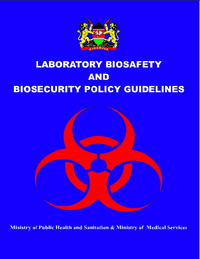Laboratory Biosafety and Biosecurity Policy Guidelines
[Biosafety and Biosecurity Guidelines]
The purpose of this document is to provide laboratories in Kenya with safe practices, guidelines, and minimum standards to improve biosafety and biosecurity. This guideline is intended to be used as a template by individual laboratories across Kenya to develop their own biosafety and biosecurity manuals.
SUMMARY
These Laboratory Biosafety and Biosecurity Policy Guidelines were written to provide laboratories in Kenya with safe practices, guidelines, and minimum standards they should use in developing and improving their own guidelines to minimize risks to personnel, the environment, and the community while handling biological and chemical agents. This guidebook is comprehensive and in accordance with the World Health Organization (WHO) guidelines on Biosafety, Occupational Safety and Health Act (OSHA) 2007 regulation, Environmental Management and Coordination Act (EMCA) 1999 and National Infection Prevention and Control Guidelines for Health Care Services in Kenya. The resource directs organizations in performing effective biorisk assessment to identify gaps, initiating corrective measures, and evaluating biorisk system performance across a range of topic areas.
This resource was compiled by the Kenyan Ministry of Public Health and Sanitation (MOPHS) and the Kenyan Ministry of Medical Services (MOMS), with financial and technical assistance from the National Public Health Laboratory Services (NPHLS) National Biosafety and Biosecurity Office, President's Emergency Plan for AIDS Relief (PEPFAR), Center for Disease Control (CDC) Atlanta, Center for Disease Control (CDC) Kenya, and Kenya Medical Research Institute (KEMRI). These guidelines are publicly accessible online as an PDF in English, and may be useful to laboratory managers, technicians, and biosafety or biosecurity managers.


..png)
